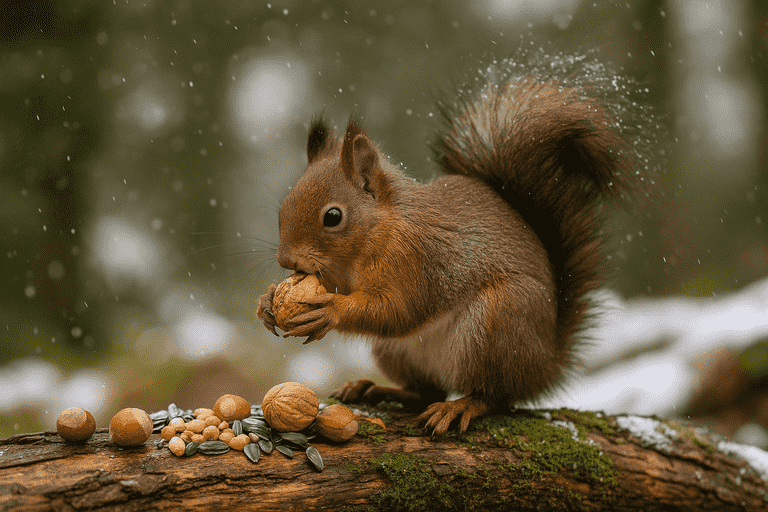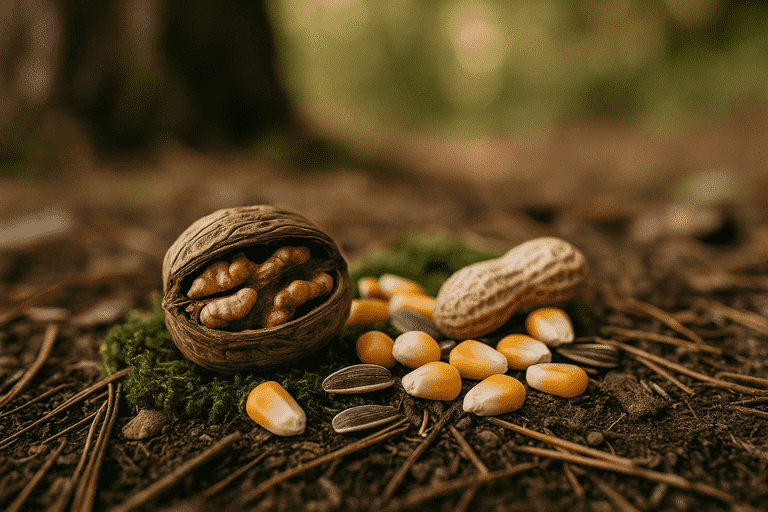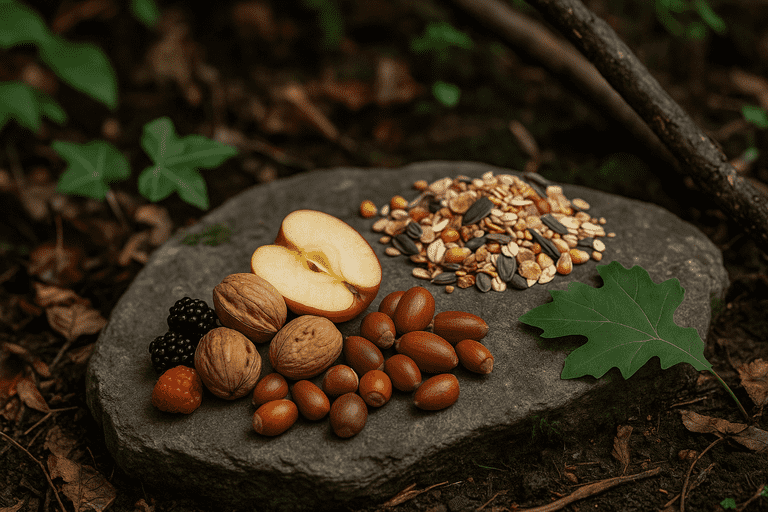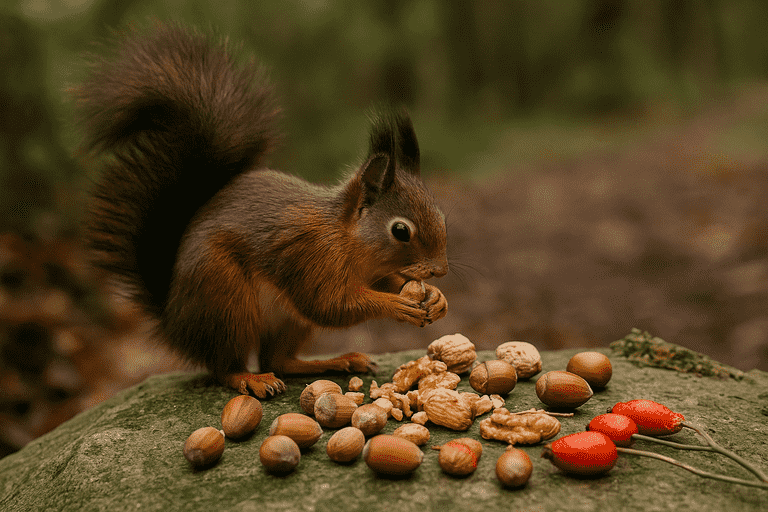Squirrels serve as important seed dispersers in forests and parks. They gather and bury food, often forgetting where they hid it. This action unintentionally leads to forest regeneration. For instance, understanding the role of wild squirrel food helps us appreciate how squirrels support plant biodiversity through everyday behavior.
Moreover, their diet reveals much about the local environment. By analyzing what squirrels eat in the wild, researchers gain insight into the health of nearby vegetation and soil conditions. Therefore, wild squirrel diets represent more than just foraging habits.
Seasonal Patterns in Wild Squirrel Food Consumption
Squirrels adapt their diet depending on the time of year. In spring and summer, they feast on fresh berries, fungi, and insects. However, when autumn arrives, squirrels shift to acorns, walnuts, and seeds, storing them for winter use. This dynamic behavior reflects the diversity of available wild squirrel food throughout the seasons.
In addition, weather and climate influence availability. For example, drought conditions may reduce fruit-bearing plants, leading squirrels to forage further. Understanding these fluctuations helps conservationists forecast changes in squirrel populations.

Nutritional Breakdown of Common Wild Squirrel Food Sources
Natural diets offer balanced nutrition that keeps squirrels healthy and energetic. Wild seeds contain essential fats, while berries provide vitamins. Mushrooms, often overlooked, supply critical minerals and support gut health. For example, wild squirrel food provides protein, antioxidants, and hydration in a perfectly natural mix.
Furthermore, a diverse diet minimizes the risk of nutritional deficiencies. In contrast, urban environments often force squirrels to scavenge processed human food, which lacks the nutrients they require. Therefore, preserving wild food sources contributes directly to animal health.
How Urbanization Threatens Access to Wild Squirrel Food
As cities expand, green spaces shrink. Consequently, squirrels lose access to native trees and plants that form the foundation of their diets. For instance, parking lots often replace oak groves, removing a vital source of wild squirrel food. This change forces squirrels to adapt by raiding trash bins or bird feeders.
Wild Food as a Gateway to Self-Reliance and Natural Living
Additionally, human development disrupts food supply chains within entire animal communities. Squirrels, birds, and insects all compete for limited resources in fragmented habitats. Therefore, restoring native vegetation can significantly improve local wildlife nutrition.

Foraging Behavior and Squirrel Intelligence
Squirrels exhibit remarkable memory and decision-making skills when selecting and hiding food. They remember hundreds of hiding spots and even practice “deceptive caching” to confuse potential thieves. This level of planning demonstrates how complex their relationship is with wild squirrel food.
Moreover, their food choices reflect instinctive awareness of nutrition and storage potential. For example, they often prioritize food with high fat content before winter. In addition, some squirrels revisit stashes to check freshness and relocate items if necessary.
Regional Variations in Wild Squirrel Diets
Depending on where squirrels live, their food options differ widely. In temperate forests, squirrels favor hickory nuts and beechnuts. Meanwhile, in arid regions, they rely on mesquite pods, pine cones, and cacti fruit. As a result, wild squirrel food varies by region, climate, and even elevation.
Why Wild Dog Food Salmon Is a Smart Nutritional Choice
Therefore, it’s important not to generalize their diet. Regional biodiversity and plant cycles dictate foraging behavior. For instance, alpine squirrels may depend on wildflowers and root bulbs, which differ from lowland species’ diets.
How Climate Change Impacts Wild Squirrel Food Availability
Changing weather patterns disrupt flowering and fruiting cycles in native plants. This delay or acceleration in plant productivity can cause mismatches in the timing of squirrel foraging. In some areas, wild squirrel food sources now appear weeks earlier or later than before, leaving gaps in seasonal nutrition.
In addition, extreme weather events like wildfires or floods destroy important food zones. Squirrels then face starvation or are forced to migrate, which affects the balance of other local species. Therefore, ecological planning must include food access for all animals.

Practical Steps to Support Wild Squirrel Food in Your Area
Anyone can help improve natural food access for squirrels. Planting native trees like oaks, hickories, and chestnuts offers reliable food year after year. In addition, allowing areas of your yard or park to grow wild increases the diversity of edible plants, fungi, and insects—creating a richer wild squirrel food landscape.
Wild Turtle Food: A Guide to Nutritional Needs
For instance, leaving fallen logs encourages mushroom growth. Also, avoiding pesticides protects the insects and plants squirrels depend on. Small efforts in backyard design or urban planning make a real difference.
Why You Shouldn’t Feed Squirrels Human Snacks
Feeding squirrels chips, bread, or candy may seem harmless, but it disrupts their health. These items offer empty calories and train squirrels to rely on humans. Instead of eating wild squirrel food, they begin scavenging for processed options that lack essential nutrients.
Moreover, this behavior leads to overpopulation in urban zones, increasing aggression, disease, and competition. Therefore, it’s far better to maintain natural food sources and resist the urge to hand-feed.

Final Thoughts on Protecting Squirrel Diets and Habitats
Squirrels are intelligent, adaptable creatures that contribute to forest health through seed dispersal and soil interaction. Ensuring their access to diverse and clean wild squirrel food supports not just their survival, but the vitality of entire ecosystems.
In conclusion, whether you’re a researcher, conservationist, or curious observer, understanding and protecting what squirrels eat in the wild reveals a deeper truth: food connects all life. By preserving natural food chains, we preserve nature itself.

